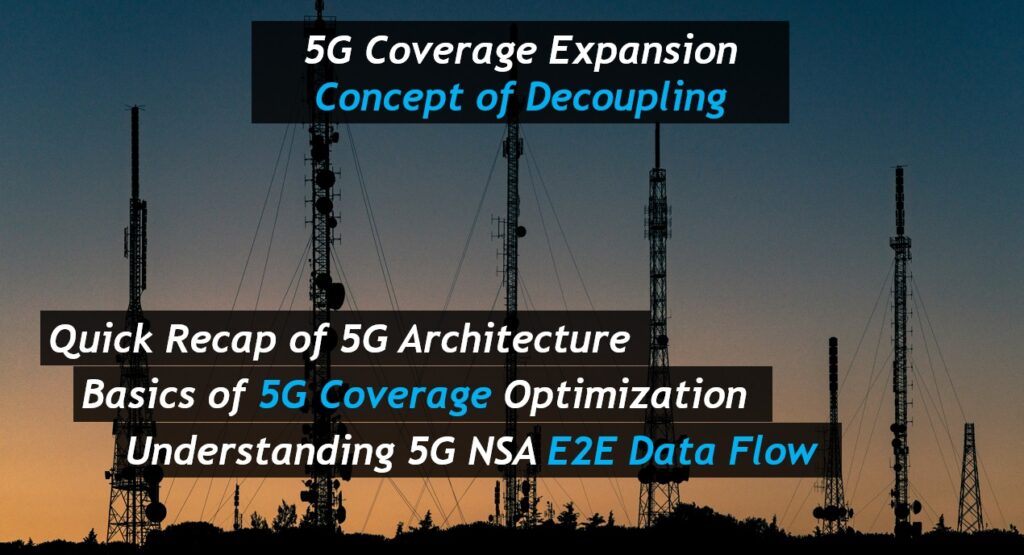“5G Coverage Expansion – Concept of Decoupling” discusses the one of the best approaches to 5G Coverage Expansion which is related to the concept of decoupling. The basic idea is to take advantage of the 5G Non-Stand Alone architecture which allows to have dual connectivity between 5G and 4G. This gives us a way to improve and expand 5G coverage using configurational changes.
5G Coverage Expansion – Concept of Decoupling
To read/watch previous reference articles and videos mentioned in this 5G coverage expansion video, please click on below links.
5G Architecture – A Summary of 5G Network Deployment Options
5G Call Flow and Signaling – How a 5G UE performs Initial Access
5G is mostly used as a capacity layer and since it is being used in NSA mode mostly so it works in sort of an overlay on LTE layer. LTE will usually have more coverage as it is a mature technology. Moreover, 5G coverage might be limited in uplink as UE power might be limited while gNB has higher EIRP (radiated power). Thus, an algorithm is needed to extend 5G coverage even when uplink coverage limit is reached. This is done by using decoupling concepts.
The concept of decoupling basically takes advantage of the NSA architecture. In Non-Stand Alone mode, the UE has to have dual connectivity which means that the UE needs to have connection with both LTE and 5G. The LTE connection carries both control plane and user plane while the 5G connection only carries user plane data. So, if the UE moves away from the 5G cell and with the assumption that the UE will be uplink limited so at a certain distance the UE will drop from 5G due to an uplink coverage related radio link failure even though the UE might still have adequate 5G Downlink coverage. To counter this issue, the system can ask the UE to start using the LTE uplink leg instead of 5G uplink. This means that the UE will keep using 5G downlink channels but it will stop using the 5G uplink channels. So, any downlink application data received on 5G will be acknowledged (application layer ACKs) on the LTE uplink channels. As LTE uplink coverage should be much better so with this scenario, we can effectively increase our 5G coverage as the UE can still get downlink data on 5G. This concept is known as decoupling!
In case you have any queries or want to connect with Ali Khalid, please feel free to drop a comment or follow him on LinkedIn. Also, if this has been helpful, then please subscribe to our Youtube channel – Our Technology Planet for more exciting stuff and videos.
Ali Khalid
Latest posts by Ali Khalid (see all)
- 5G Coverage Expansion Analysis – Find The Optimal 5G Coverage Threshold For Your Network - November 9, 2024
- 5G Coverage Expansion - November 9, 2024
- 5G SA Cell Search & Network Entry Matrix - July 18, 2023

FiveM MLO (Multi-Level Object) is a custom object that can be add to a Fivem server.
They are designe to be fully interactive with the game environment, allowing player to interact with objects in ways that would not be.
At our FiveM MLO store, we are committe to providing the highest quality and most immersive MLOs for your server. Here’s why you should choose us.
Buying Fivem MLOs enhances your gaming experience by providing unique, customize maps, houses, and interiors, adding immersive and exclusive elements to your Fivem server.